Eduard Rubin ought to be a household name to gunnies the world over. Why? He invented the full-metal-jacketed bullet back in 1882. Oddly, the bullet was paper patched, much like the old lead bullets were patched for many years prior to that date, but his was apparently the first metal-jacketed bullet to be paper patched. This technique is still occasionally useful today to bump up a bullet’s diameter to make it fit an odd bore size.
Along his way Mr. Rubin came up with several cartridge designs, his most famous being the 7.5×55 Swiss, which essentially has defended Switzerland since 1889. The cartridge in nearly identical form is still used today in the Swiss M51 machine gun, and by home reserve units. Today’s version of the cartridge, known as the GP11, brought out in 1911 like our test rifle, uses a boat-tailed bullet of 174 grains. That ammunition played a big part in U.S. military cartridge development.
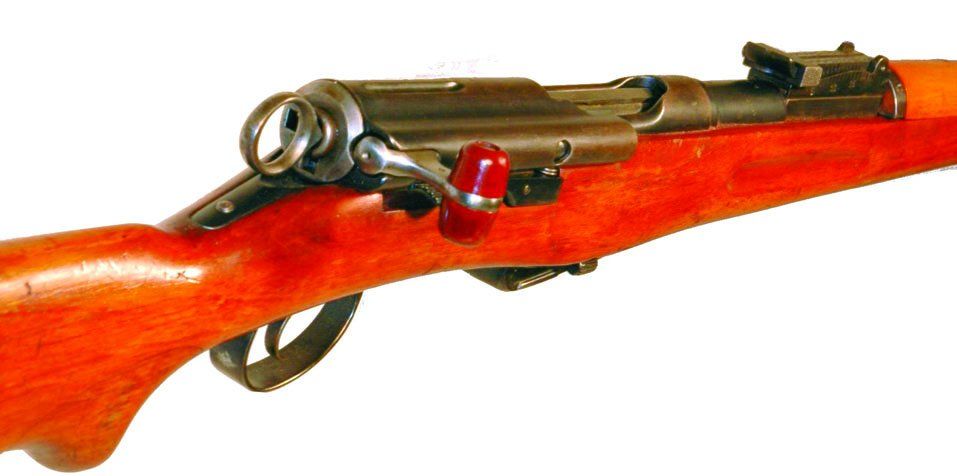
During the first World War, the then-current version of the 30-06, with 150-grain flat-base bullet, was found to give poor performance at long range. This was discovered after U.S.-made machine guns finally replaced the foreign-made ones the U.S. had been using. At the time, long-range cover or blanketing fire from machine guns was key to military operations, though that is not the case today. The original 30-06 ammo was supposed to have a maximum range of close to three miles. It was found to have a true range of less than two miles. After the war the U.S. was determined to fix that, and began serious testing. In the process the Swiss GP11 ammunition, with the same-diameter bullets, was evaluated and found to be vastly superior to the 30-06. In light of the great performance of the Swiss ammo at long range, the U.S. testing team loaded Swiss bullets into our 30-06 brass and found it to be far better than even the U.S.’s specially loaded 180-grain match ammo. It was thus determined the 30-06 needed a boat-tail bullet. But what angle should the boat-tail be? Empirical testing, under the direction of Col. Townsend Whelen, of a variety of bullets having boat-tail angles from 2 to 12 degrees determined that 9 degrees was the best. The cartridge redesign was finalized in 1925 (under Julian Hatcher) and became known as 30-06 M1 Ball ammunition. It shot a 174-grain, 9-degree boattail bullet at 2700 fps, and had a maximum range of about 3.3 miles, a big jump forward from the 30-06’s performance over the trenches in WWI. So it’s in large part thanks to the Swiss and to Mr. Rubin for the highest mil-spec development of the 30-06, the M1, which lived from 1925 to about 1940. Incidentally, much of the early testing of U.S. mil-spec ammo was done at the annual matches at Camp Perry, Ohio, and on Daytona Beach in Florida.
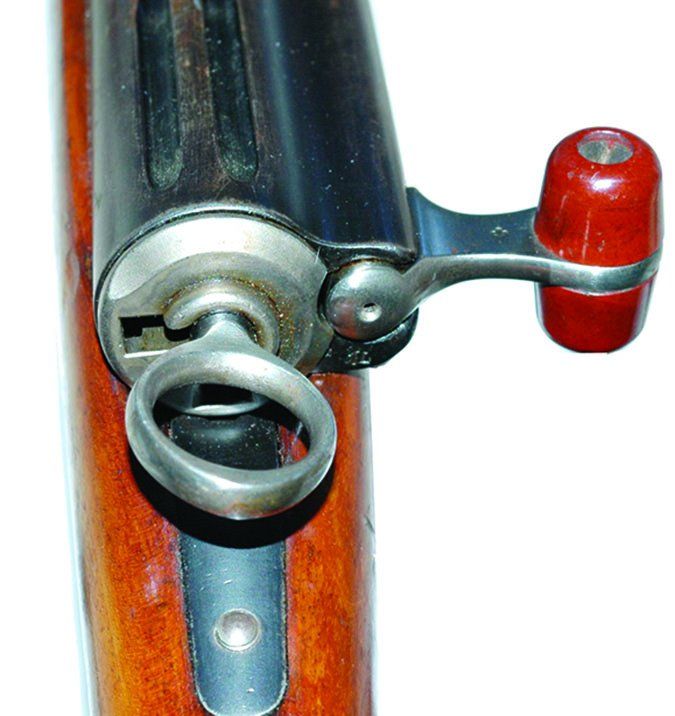
Our test rifle here is a Schmidt-Rubin Model 1911. These rifles were made in a variety of models and lengths, including carbines, over the years as various small improvements came along to correct some of the initial shortcomings of the rifle. Commonly available on the U.S. surplus market for many years, the S-R never sold in vast quantities despite attractive prices, most likely because the ammo was somewhat hard to get and the action didn’t permit transformation into a suitable sporterized form. Although the Schmidt-Rubin was not designed to be a sporter, we suspect a clever stock maker could make up a shorter-barrel version of this (carbines have 24-inch barrels) into an attractive custom rifle, much as Al Linden did long ago for the Krag. We tested our rifle with three types of ammo. This was Swiss Army issue GP11 with 174-grain FMJ bullets, Wolf soft-nose 174-grain bullets, and Hornady’s 165-grain soft-nose load. Here’s what we found.
Schmidt-Rubin Model 1911, 7.5x55mm Swiss, about $350
Once again we have a really snappy example of the species for our test. The bore, all 30.7 inches of it, looked like it was new. The muzzle was fitted with a clever snap-over cap, made of brass and spring steel, to keep crud out. The light-colored stock, most likely some form of birch, was decent looking with what seemed to be its original finish, though it had plenty of small dings and nicks. The metalwork and bluing were also in very good condition, retaining about 90 percent finish. The detachable magazine held six rounds and was extremely easy to load. We thought the metal finish was pretty good, not a shiny finish nor entirely dull, most certainly not crude, generally well done, and essentially equal to the finish on many modern rifles.
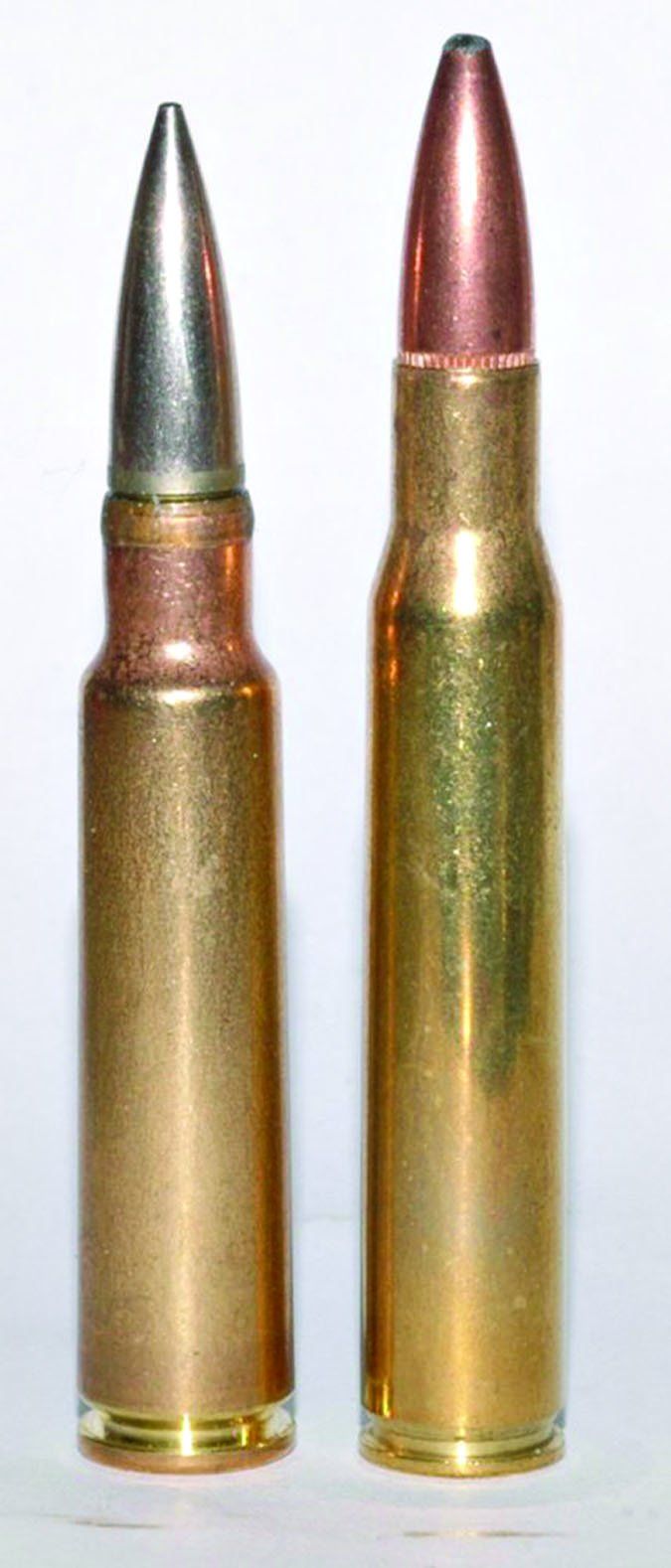
Rudolf Schmidt designed this action, and the great Swiss craftsmen brought it into a viable form that lasted a long time. To operate the rifle, the soldier did not have to learn how to twist a conventional bolt. All he had to do was grab the twin knobs on the right side of the action, heave them straight back, and shove them straight forward. This was undoubtedly faster for the average man to operate than all but the most skilled conventional-bolt operators. We kept trying to twist the lever downward after a new round went home, but we quickly adapted. Despite the great length of the rifle we did not find it to be clumsy, though it took some getting used to its 51.5 inches of length. We thought the sights were on the small size for fastest use, but serviceable. The rear was graduated out to 2000 yards and had a small U-notch, and the front was a flat-top post in a dovetail. The stock went almost all the way to the muzzle, and covered the barrel all the way but for the last 2.5 inches. That long, slim stock was just over 48 inches long. It was of hard wood, and had a pistol-grip insert added. The upper hand guard was just over 21 inches long. There was a bayonet lug on the forward barrel band and a stacking hook under the muzzle affixed to that same band. The forward barrel band was inletted into the wood. It was fitted with a stout screw to retain it, and opposite the screw was a hinge to permit removal of the band. All the visible numbers were matching including on the magazine. Even the curved and coned steel butt plate held the last three digits of the serial number.
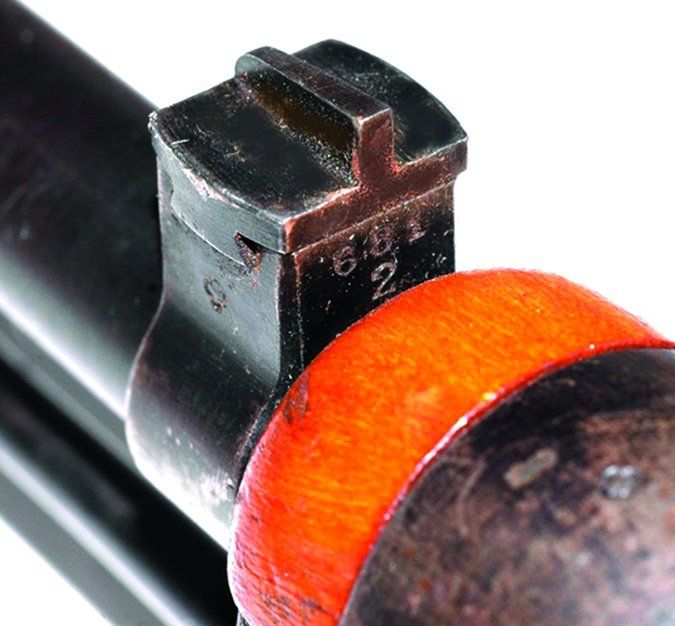
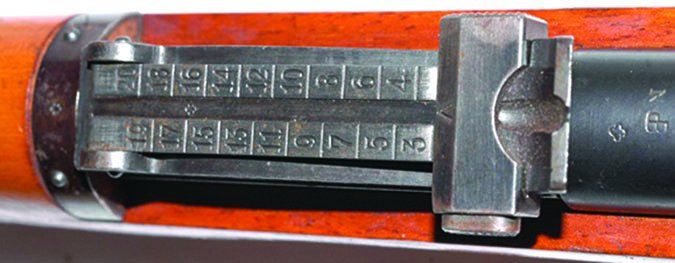
A pleasant surprise for us was that the stock inletting was extraordinarily well done for a military rifle. It was better than that found on many modern sporting rifles. Even the rear sling swivel was carefully inletted into the stock. The action had two parallel, round-bottom grooves on top of the rear bridge in line with the bore. There was another rounded groove on the left side of the action adjacent to the action opening. We found some sticky old oil here and there that would have to be detail cleaned by the new owner. Although we cleaned it, the gummy oil did not seem to harm the rifle’s function. One of the things that modern rifle makers should note is the S-R’s action opening had nicely rounded edges, giving no chance of cutting your fingers anywhere. Another nice touch on our test rifle was that the two red knobs on the bolt handle were pristine, and that’s apparently not common.
In order to get the rotary motion to the bolt as it’s slammed back and forth, the bolt has spiral grooves milled into its rather large outer surface. With those deep, curved grooves, the odd cocking-and-safety hoop at the back, and the action’s peculiar operating mode, the Schmidt-Rubin resembles not so much a rifle as a machine into which you put ice and Scotch, slam the bolt closed, and pour a perfect highball out the muzzle. Intoxicating! In our test example of the Schmidt-Rubin, the locking lugs are about midway along the length of the bolt, up toward the front of the big sleeve and right behind the shaft that one sees when the bolt is closed. A further development some years later did away with the forward shaft of the bolt and moved the sleeved portion forward so the locking lugs ended up in a conventional location, right behind the head of the cartridge. In the original design the lugs were at the extreme rear of the big sleeve, about nine inches behind the chamber.
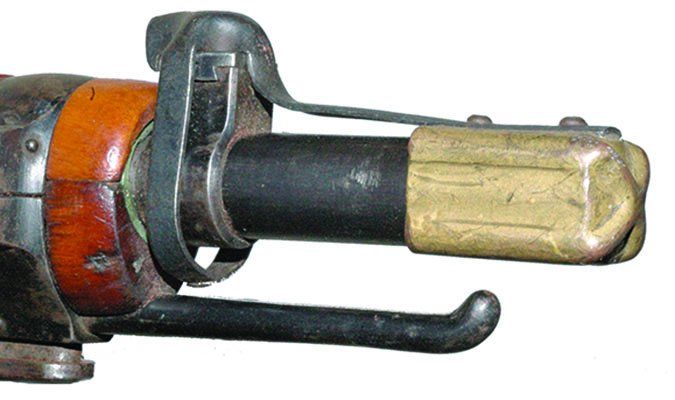
That odd hook or loop at the back of the bolt permits recocking the rifle in the event of a misfired primer. It is also the safety. Pull it out, rotate it 90 degrees clockwise and let it slip into a second notch, and the rifle cannot be fired nor the action opened. The front of the bolt holds the extractor, which snaps over the cartridge as the bolt closes. To get the bolt out of the rifle, pull it all the way back and then push it slightly forward. Then depress that big lever under the right side of the action, and the bolt can be withdrawn. That lever that you just pushed down also acts as the spring to hold the bolt open or closed. It is in operation every time the bolt is moved through its full travel.
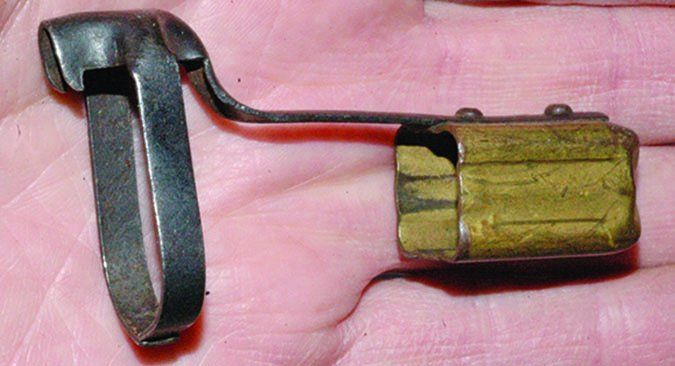
Feeding was, like the bolt movement, as slick as sliding steel on oiled glass. All three types of ammo, even the rather short Hornady rounds, fed with ease. We were also happy with the two-stage trigger pull, which broke at 2.8 pounds cleanly. On the range we found the sights to be on the money. They were perfectly centered and elevation with the rear slider all the way down was about two inches at 100 yards. Because of bad weather we shot the rifle at 50 yards. Shooting the rifle was most pleasant. The weight cut recoil to a nudge, and the perfect function and easy-loading magazine made our testing chores light and pleasant. All the ammo fed, fired, and ejected smoothly and easily. Once we became familiar with the action we found it easy and fast to get the next round ready to go. Accuracy was all that anyone would desire, the best groups going under 1.5 inches at 50 yards, with some clusters around an inch, and one doozy at 0.4 inch, three shots touching, which we could not duplicate. That one was with the mil-spec ammo and a cold barrel. All told, the accuracy translates to a little over two inches at 100 yards. For a mil-spec rifle, we thought that was excellent.
Our Team Said: We could not fault the rifle. It was fun to shoot, accurate, and enough different to keep one’s interest up. Students of rifle mechanisms will have lots to examine in this one. There are lots of variations if one wants to collect Schmidt-Rubin rifles, and many of them are quite affordable. Ammo seems to be easy to get today. Bullets for reloading are easy, being the most common 30-caliber size. When you first operate a Schmidt-Rubin and run the fired case out and a new one in, you’ll probably ask yourself, “Is that all I have to do?” Yep, it’s that easy. Please note that the early versions of this rifle can’t safely handle the pressure of the latest GP11 ammo. If in doubt, ask a qualified gunsmith.
Written and photographed by Ray Ordorica, using evaluations from Gun Tests team testers.


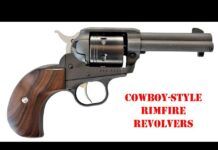

























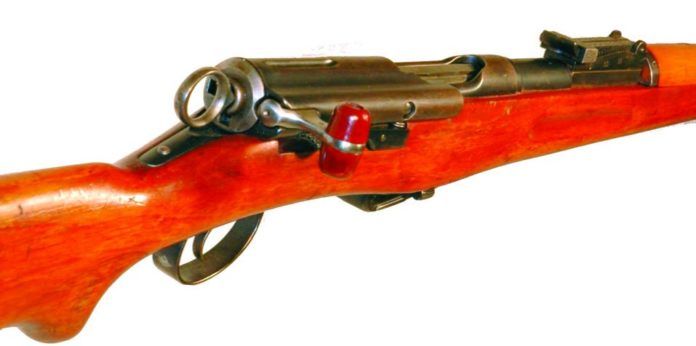

The grafted pistol grip identifies this as a model 1896/11 rather than a model 1911 rifle. The 1911 stocks have the pistol grip as an integral part of the wood, while the 1896/11 had it grafted in when the old 1896’s (which did not have a pistol grip) were refurbished to handle GP 11 ammo.